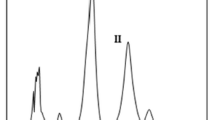Abstract
A precise single residue analytical method was developed for fungicide cyazofamid in various crops. Apple, mandarin, Korean cabbage, green pepper, potato, and soybean were selected as representative crops, and clean-up system, partition solvent and extraction solvent were optimized. Limit of quantitation (LOQ) of cyazofamid was 2 ng (S/N>10) and good reproducibility was observed with small coefficient of variation (<4%). Excellent linearity was achieved between 0.05 and 20 mg/kg of cyazofamid standard solutions, with coefficients of determination of 1.000. Method limit of quantitation (MLOQ) was 0.02 mg/kg. For recoveries tests, crop samples were macerated and fortified with cyazofamid standard solution at three fortification levels (MLOQ, 10 MLOQ, and 100 MLOQ). And then those were extracted with acetone, concentrated and partitioned with dichloromethane. Then the extracts were concentrated again and cleaned-up through Florisil® column with ethyl acetate: n-hexane (30:70, v/v) before concentration and analysis with HPLC. Good recoveries from 75.3 to 98.5% with coefficients of variation of less than 10% were obtained, regardless of sample type, which satisfies the criteria of KFDA. Those results were reconfirmed with LC-MS/MS. The method established in this study could be applied to most of crops as an official and general method for residue analysis of cyazofamid.
Similar content being viewed by others
References
Ahmed FE (2001) Analyses of pesticides and their metabolites in foods and drinks. Trac-Trends in Anal Chem 20, 649–661.
Choi JH, El-Aty AMA, Park YS, Cho SK, and Shim JH (2007) The assessment of carbendazim, cyazofamid, diethofencarb and pyrimethanil residue levels in P. ginseng (C. A. Meyer) by HPLC. Bull Korean Chem Soc 28, 369–372.
Codex Alimentarius Commission (2003) Guidelines on good laboratory practice in residue analysis, CAC/GL 40-1993, Rev. 1-2003, Rome, Italy.
Evaluation Report Cyazofamid (2004) Pesticides Experts Committee. Food Safety Commission, Tokyo, Japan.
Fong WG, Moye HA, Seiber JN, and Toth JP (1999) In Pesticide Residues in Foods: Methods, Technologies, and Regulations, John Wiley & Sons, Inc., New York, NY.
González-Álvarez M, Noguerol-Pato R, González-Barreiro C, Cancho-Grande B, and Simal-Gándara J (2012a) Changes of the sensorial attributes of white wines with the application of new anti-mildew fungicides under critical agricultural practices. Food Chem 130, 139–146.
González-Álvarez M, González-Barreiro C, Cancho-Grande B, and Simal-Gándara J (2012b) Impact of phytosanitary treatments with fungicides (cyazofamid, famoxadone, mandipropamid and valifenalate) on aroma compounds of Godello white wines. Food Chem 131, 826–836.
González-RodrÍguez RM, Cancho-Grande B, and Simal-Gándara J (2011) Decay of fungicide residues during vinification of white grapes harvested after the application of some new active substances against downy mildew. Food Chem 125, 549–560.
Korea Food and Drug Administration (2010) Food Code, KFDA, Osong, Korea.
Korean Crop Protection Association (2010) Pesticide Handbook. Korean Crop Protection Association, Seoul, Korea.
Lee JH, Park HW, Keum YS, Kwon CH, Lee YD, and Kim JH (2008) Dissipation Pattern of Boscalid in Cucumber under Greenhouse Condition. Korean J Pest Sci 12, 67–73.
Lee YD (2011) Practical guide for food code pesticide residue analysis (Extended ed.), Korea Food and Drug Administration, Osong, Korea.
McNair HM and Miller JM (1998) In Basic Gas Chromatography, Wiley, New York, NY.
Miller JM (2005) In Chromatography: Concepts and Contrasts, Willy, Hoboken, NJ.
US EPA (2004) Pesticide Fact Sheet. US EPA, Washington DC.
Pesticide Residue Analytical Group (2006) New pesticide residue analytical method, (Rev. ed.), PRAG, Tokyo, Japan.
Rood D (2007) In The Troubleshooting and Maintenance Guide for Gas Chromatographyers, (4th ed.), Wiley-VCH, Sacramento, CA.
Suciu NA, Ferrari T, Ferrari F, Trevisan M, and Capri E (2011) Pesticide removal from waste spray-tank water by organoclay adsorption after field application to vineyards. Environ Sci Pollut Res 18, 1374–1383.
Taylor MJ, Hunter K, Hunter KB, Lindsay D, and Le Bouhellec S (2002) Multi-residue method for rapid screening and confirmation of pesticides in crude extracts of fruits and vegetables using isocratic liquid chromatography with electrospray tandem mass spectrometry. J Chromatogr A 982, 225–236.
Tomlin C (2006) In The Pesticide Manual: A World Compendium, (4th ed.), British Crop Production Council, Alton, Hampshire, UK.
Ware GW and Whitacre DM (2004) In The Pesticide Book. (6th ed.), Meister Media Worldwide, Willoughby, OH.
Author information
Authors and Affiliations
Corresponding author
Rights and permissions
About this article
Cite this article
Lee, H., Kim, E., Moon, JK. et al. Establishment of analytical method for cyazofamid residue in apple, mandarin, korean cabbage, green pepper, potato and soybean. J Korean Soc Appl Biol Chem 55, 241–247 (2012). https://doi.org/10.1007/s13765-012-1042-8
Received:
Accepted:
Published:
Issue Date:
DOI: https://doi.org/10.1007/s13765-012-1042-8




